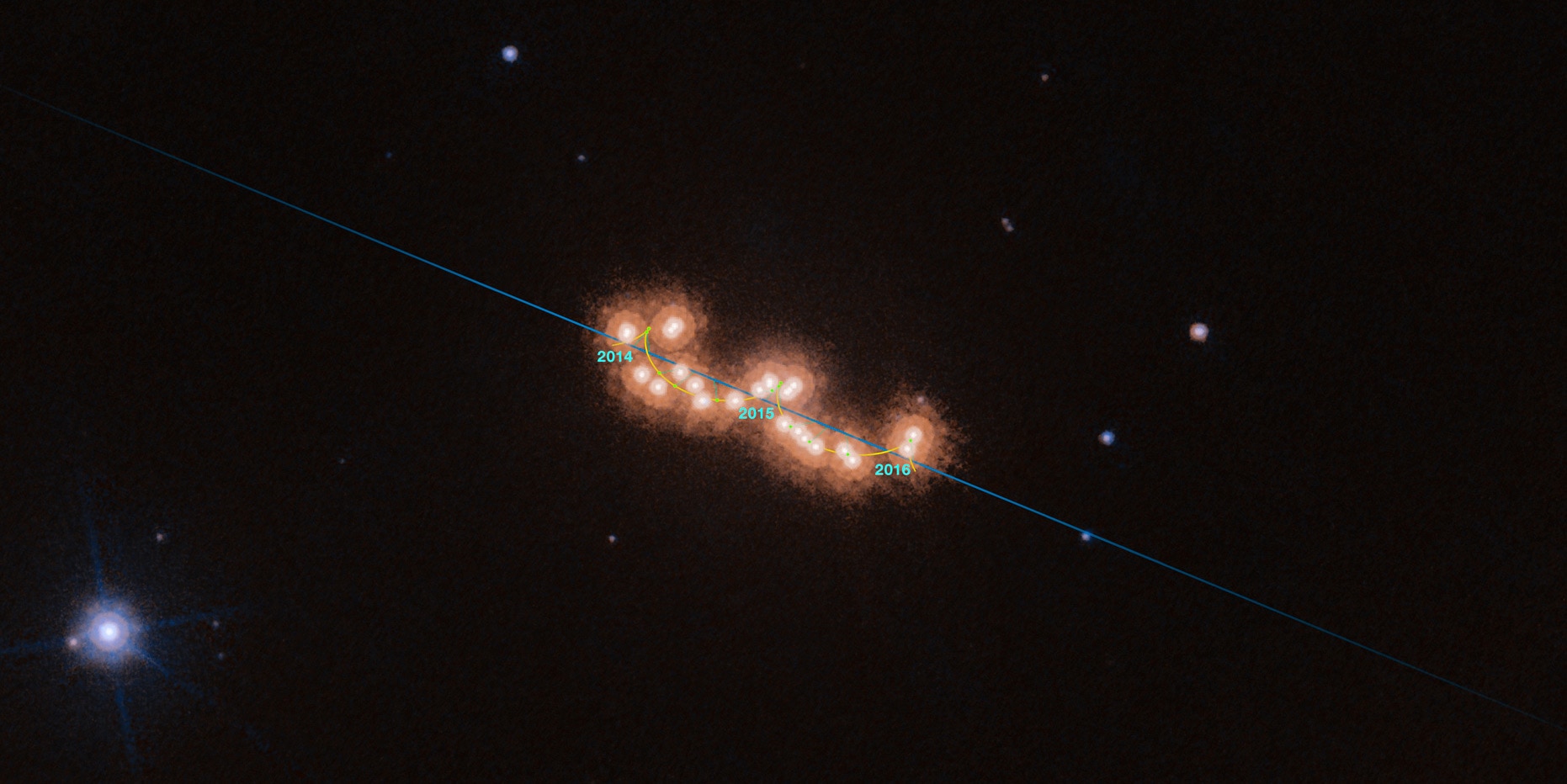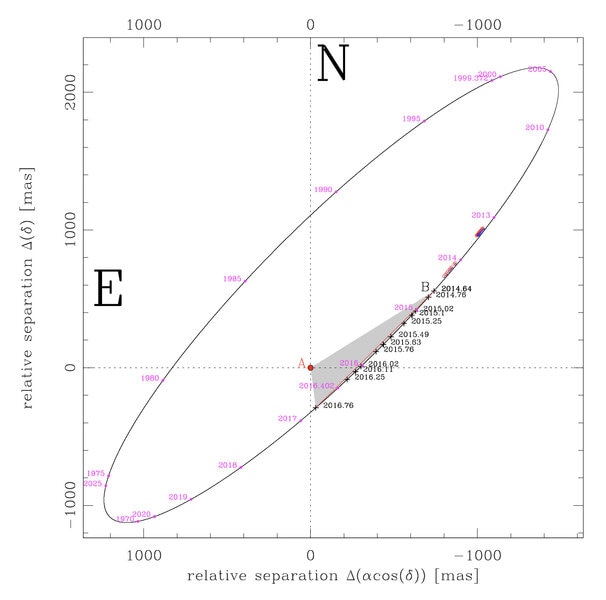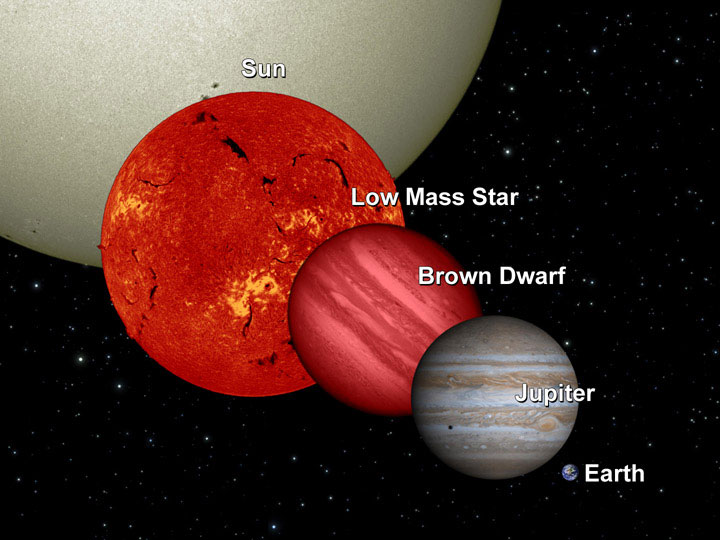Create a free profile to get unlimited access to exclusive videos, sweepstakes, and more!
Amazing Hubble astrovideo: Two brown dwarfs dance across the sky

One of the things I truly love in astronomy is when you can see things actually physically moving in the sky.
For the most part, objects in the cosmos are so far away that, to us, their true motion is reduced to nearly nothing. Even something screaming along at hundreds of kilometers per second looks motionless when it’s a thousand trillion kilometers away or more.
But for some cosmic denizens, their motion is observable. Sometimes it’s because they’re moving so rapidly (at a decent fraction of the speed of light, in some cases) that movement is discernible over less than a human lifetime.
In others, it’s because they’re so close to us that perspective hasn’t crushed their motion to invisibility. What’s cool about those is that we can see our own planet’s motion reflected in theirs, too!
To wit, I present to you Luhman 16 A and B, a pair of brown dwarfs orbiting each other in a binary system. Brown dwarfs are objects more massive than planets, but without the mass needed to fuse hydrogen into helium in their cores, so they’re not quite stars, either. The brown dwarfs of the Luhman 16 system are very faint, which is why they weren’t discovered until 2013. That despite being a mere 6.5 light-years from us, making them the fifth and sixth closest objects known outside our solar system (only the Alpha Centauri system and Barnard’s star are closer)!
This is so close that their apparent motion is ... complicated. You can see this for yourself: A team of astronomers has observed the pair for the past few years and created an animation using the actual Hubble images — what you see here is not a computer animation, it’s the actual observations of these brown dwarfs!
Holy wow. What you’re seeing is actually a combination of three separate motions.
The biggest is the proper motion of two brown dwarfs, showing their physical motion relative to the Sun. That goes from the upper left to the lower right.
The second is the loop-de-loop they make as they move. That is a reflection of the Earth’s motion around the Sun, what’s called parallax. As it happens, I know a wonderful description of this by a charming astronomer (cough cough). Basically, as the Earth goes around the Sun, our viewing angle to a star changes, and so we see it move relative to more distant stars. Since our orbit is pretty close to circular, we see the stars making teeny loops in the sky (generally speaking they make ellipses; only stars exactly above or below the Earth’s orbital axis would make near-circles).
If Luhman 16 were stationary relative to the Sun, we’d see the stars making a closed ellipse, cycling forever. But since they’re moving as well, these combine to make the weird traveling loops.
The third motion is even cooler: It’s the orbital motion of the two brown dwarfs around each other! At the start of the video you can see they’re cleanly separated by Hubble, but by the end they’re much closer together. That’s real.
From the observations, the stars have an orbit that’s a little over 30 years long. There’s some uncertainty there, because the span of time the observations cover isn’t long enough to really nail the orbital parameters down. But it looks like their mutual orbit is moderately elliptical with a diameter along the long axis of about 570 million kilometers, a somewhat smaller orbit than Jupiter's as it orbits the Sun.
The size and period of the orbit also can be used to figure out the masses of the two objects. Luhman 16 A is about 32 times Jupiter’s mass, and Luhman 16 B about 27. That means both are far less massive than the Sun (combined they equal 0.056 the Sun’s mass), which is consistent with them being brown dwarfs.
There’s something else the orbit reveals ... or doesn’t reveal, which in fact is why these observations were made in the first place: The astronomers looked at them to see if there were planets orbiting the objects. It would be really unlikely to see the planets directly; the brown dwarfs are so faint that any planet orbiting them would be only feebly illuminated by them.
Instead, they looked for wobbles in the orbits of the dwarfs to look for the tug of a planet as it orbited both of them. The gravity of any supposed planet would pull on them, and that would show up as a deviation from an ellipse in their own orbits. Ground-based observations indicated a planet might be there, but these kinds of observations are very difficult to make using Earthbound telescopes.
Hubble is above the Earth’s atmosphere and has very sharp vision, making this kind of thing much easier. Again, the time baseline of these observations isn’t quite long enough to be certain if any planet exists, but some things can be ruled out. For example, the gravitational effects of any planet with more than two times Jupiter’s mass on an orbit up to two years in length would’ve been seen, so that’s ruled out. Even a Jupiter-mass planet with an orbit between 20 to 200 days would’ve been detected as well. They can also say that a Neptune-mass planet (about 17 times Earth’s mass) with an orbit longer than a year or so can’t be there, either.
Don’t despair (yet)! There could be a smaller planet orbiting the dwarfs. Something like the Earth would have too small an effect to be detected with these observations. More are needed. Incidentally, it’s unlikely that there’s a planet orbiting just one of the two dwarfs. The gravity of the other dwarf would quickly destabilize the planet if it weren’t very close in. It may not be impossible, but to be honest, I wouldn’t bet either way. Nature is tricky.
Finding exoplanets orbiting brown dwarfs is very rare; only a few have been detected (and one of them was the first exoplanet ever to be directly imaged). You might expect them to be common; we find lots of low-mass roughly Earth-sized planets orbiting smaller stars than bigger ones. Does that trend continue down to brown dwarfs? No one knows. But it’s really hard to find such planets. Besides lacking illumination, even the transit method is hard with brown dwarfs because they’re so faint. Our best bet is to look at the handful of nearby ones and try to measure their motion to see if they’re getting yanked around.
But astronomers will keep looking! We’re really interested in finding planets, including ones in weird places. The more we find (or don’t find, really) the more we learn about the way planets form and evolve, and what their environments were like.
These questions were completely unanswerable not too long ago (the first exoplanet wasn’t confirmed until the 1990s, and heck, even the first brown dwarf wasn’t found until around the same time). Yet here we are, investigating these questions and getting answers!
This is an amazing time to be an astronomer, or someone interested in astronomy. If you’ve read this far, then that’s you! Thanks for coming along. It’s been a fun journey, and it’ll continue to be one for a long time. There’s lots left to discover.





























